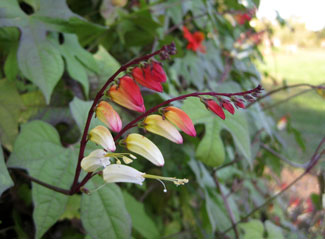Resource Library
Plant of the Week: Spanish Flag
Spanish Flag
Latin: Iponoea lobata (Mina lobata)
Spanish Flag -- Spanish Flag is a fast growing, fall blooming vine of the morning glory family that has come and gone in gardens since it was first grown. (Image courtesy Gerald Klingaman)
Likewise, gardeners have a choice in accepting or rejecting the lawmakers in the botanical world – the taxonomists that change plant names. Ipomoea lobata, known as Spanish flag, is the sanctioned name for this fast-growing annual vine, but to most gardeners it is known by its original name Mina lobata.
Spanish flag, also known as firecracker vine and exotic love vine, is a fast-growing, frost-tender perennial vine of the morning glory family. It climbs by twining around support and in a matter of two months can climb to a height of 18 feet given plenty of moisture and warm growing conditions. Its 3-inch long leaves have three prominent lobes and are often purple tinged as they emerge and again in the fall.
Flowers appear in late summer and fall from axillary nodes. They are produced on forked racemes that bear upwards of 12 to 15 banana-shaped blossoms per floral branch. The blossoms nearest the end of the floral stem are orange-red in color, but as they enlarge and age they transition to infused shades or orange and cream, finally reaching maturity as a rich cream color with stamens and the pistil prominently extended from the end and about as long as the floral tube. The corolla is about an inch long.
Spanish flag, so named because the blossoms array themselves along one side of the floral branch like flags blowing in the wind, are short day plants. Some gardeners report them blooming in June and July, but they are almost always located in northern climates such as England and Canada. Temperature and photoperiod work together to initiate bloom set in short day plants. If the average daily temperature is low enough, the photoperiod effect can be overridden by temperature and plants will bloom earlier in the season.
Spanish flag was first described and named in 1824 to honor Francisco Xavier Mina, a Spaniard who led a force into Mexico on the side of Mexican independence but was captured and executed in 1817. After its botanical description in 1824, it was introduced into European cultivation in 1841 but soon lost, probably because seeds did not mature in the northern climes. In 1887, it came to the United States, this time due to the efforts of a German seedhouse. After a short run of popularity, it again disappeared but resurfaced in the late 20th century and is now offered by several seed companies.
From the very beginning Spanish flag’s affinity to morning glories, Ipomoea, has been recognized and several names have been proposed with consensus finally settling on Ipomoea lobata. But, because the flowers don’t look anything like those of a morning glory, gardeners (the governed) have largely rejected the authorities and mostly stayed with the original name of Mina lobata.
Whatever it is called, this fast-grower is useful to cover trellises and fences in the garden. Seed we planted out in early June climbed to the top of an 18-foot tall trellis within two months. Flower production began in late September and continued until the first frost. For us, seed production is usually iffy, which is a good thing because some members of the morning glory family – no matter how beautiful in flower – can become weedy if seed production is too successful.
By: Gerald Klingaman, retired
Retired Extension Horticulturist - Ornamentals
Extension News - November 22, 2013
